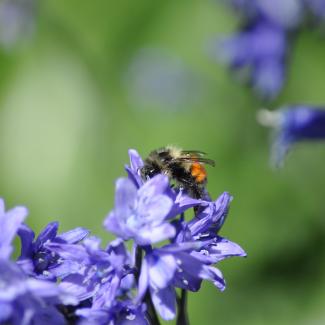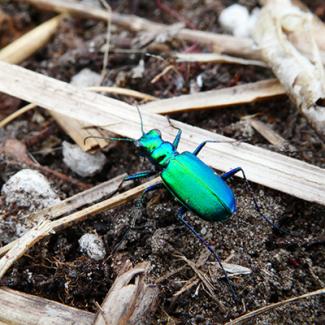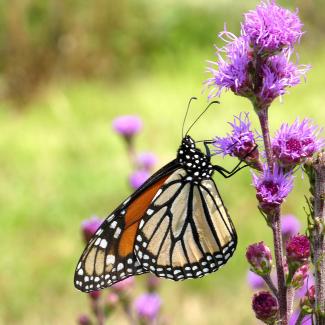Floater, Sheepnose, and Cat’s Paw: Exploring the Fascinating World of Freshwater Mussels
41 MinutesGuests: Emilie Blevins, Jack Fetters
We are going underwater to highlight an invertebrate that isn’t an insect — the freshwater mussel. These animals may not be well-known but are powerhouses in our freshwater ecosystems, playing a critical role in our lakes and rivers.
Buzzing Canopies: Forests' Vital Role in Supporting Pollinator Diversity
38 MinutesGuests: Kass Urban-Mead
For many of us, if we were asked to describe a place that is good for bees, we’d likely talk about somewhere that is open, sunny, and full of flowers — a garden, meadow, prairie, or hedgerow, maybe. The chances are that forests wouldn’t be high on that list. However, forests provide important resources for bees.
Bumbling Through Nature: Exploring the Fascinating Life History and Community Science of Bumble Bees
45 MinutesGuests: Rich Hatfield
Spend time in a garden and you’ll probably hear the buzzing of a bumble bee. These charismatic bees pollinate many of the foods and flowers that we love and, similar to other bees, their populations are in decline. Fortunately, there is a community science program to help us better understand the abundance and distribution of bumble bees across the US.
Life in the Dark: How Artificial Light is Impacting Insects
43 MinutesGuests: Dr. Avalon Owens
Light pollution. Go outside at night and you’ll notice it — lights on buildings, in gardens, along streets, glowing on the horizon. It might not seem like much, but this is changing the world for animals that rely on darkness. Imagine evolving for millions of years with only the stars and moon and now being faced with a landscape full of additional light. What happens to insects when the night is full of light? Can fireflies coexist in urban areas? Are there things we can do to reduce our impact?
The Magic of Fireflies: Flashing Lights, Glowing Worms, and Chemical Reactions
41 MinutesGuests: Richard Joyce
Fireflies. Just the word evokes for many people memories of summer evenings filled with magic and awe. From their flashy mating displays to their glowing larvae, these iconic insects have captured our hearts. Unfortunately, fireflies have started to disappear from the landscape. What is causing this decline and what can we do to help?
Surviving Winter: What Heat-Loving Butterflies Do During the Cold Months
40 MinutesGuests: Kevin Burls
We’ve previously talked about overwintering monarchs seeking refuge in warmer climates, but what do other butterflies do during the winter? Do they also migrate? Do all butterflies overwinter as adults? If so, where do they hide — in leaves or rock piles or up in the trees? If not, how do they survive — what do these warm-loving butterflies do during the winter?
Nature's Original Transformers: The Amazing Beetles
35 MinutesGuests: Jennifer Hopwood
We are all familiar with beetles. If we look around our homes or neighborhoods, we’ll find them, but how familiar are we? What makes a beetle a beetle? How many different species are there? What role do they play in our world?
Saving the Bees: Why Honey Bees Are Not the Answer
44 MinutesGuests: Rich Hatfield
No bee is as popular as the honey bee. When we think of a bee, many of us think of this charismatic social bee that lives in large colonies, does the wiggle dance, produces the honey we love, and pollinates many of our crops. Although honey bees can be found all over North America, they only arrived in the seventeenth century by way of European settlers. Aside from honey bees, in North America, thousands of native bees can be found on the landscape. We’ve all heard that bees are in decline. As a non-native species, are honey bees the answer to helping us “save the bees”? How do honey bees interact with our native bees on the landscape?
A Monarch's Life: Migration, Survival, and Barfing Blue Jays
40 MinutesGuests: Ray Moranz
We've recently talked about western monarch populations and community science. Today, we are going to talk about monarchs east of the Rockies. From their overwintering sites to their multi-generational migration, and the stops along the way, we will take a deeper look at the journey of the monarch.
When a Bee is Considered a Fish: The Definitions and Complexities of Endangered Species
33 MinutesGuests: Sarina Jepsen
The word “endangered” is widely used when talking about rare animals in news reports, conservation campaigns, TV documentaries, and more. Sometimes being endangered is seen as a benefit, other times as a bad thing — but what does it mean? As with so many things, what lies behind the word “endangered” is more complicated than what meets the eye, and the word is not always used consistently, which can lead to confusion. Are honey bees endangered? No, there are millions of hives. Is the rusty patched bumble bee endangered? Yes, it is protected under the Endangered Species Act. What about the monarch butterfly? Probably, but not officially — and if they are protected, they may be classified as “threatened” — and is that at the federal or state level (or maybe internationally)? Are you confused yet?










